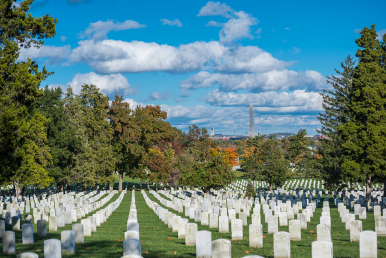Fix-it shop
Arlington Economic Development expands its toolbox

Ryan Touhill was appointed director of Arlington Economic Development in November 2022. He formerly served as senior vice president and chief of staff for the Alexandria Economic Development Partnership. Photo by Shannon Ayres

Ryan Touhill was appointed director of Arlington Economic Development in November 2022. He formerly served as senior vice president and chief of staff for the Alexandria Economic Development Partnership. Photo by Shannon Ayres
Fix-it shop
Arlington Economic Development expands its toolbox
Since becoming Arlington County’s economic development director in November 2022, Ryan Touhill’s most pressing challenge has been sharply delineated: The county’s office vacancy rate has hit 23.7%, nearly twice the national rate of 13.1%, a record high itself, according to the National Association of Realtors.
Like other localities, Arlington is coping with multiple factors that create urban building graveyards: fully remote white-collar jobs, hybrid work policies that require less office space, and a preference among businesses for streamlined, modern offices ready for the latest technology, as opposed to aging facilities.
Considering how best to generate tax revenue for the county, Touhill says, his immediate concerns are, “How do we drive more demand? How do we remove oversupply of office space? How do we impact value?”
Arlington’s certainly not alone in asking such questions, although its situation is more dire than other Virginia localities. In Richmond, just 10% of offices are sitting empty, and only 8.1% in Hampton Roads, according to statistics released for 2023’s first quarter. As of July, Fairfax County had a 16.7% office vacancy rate, and Washington, D.C.’s rate was 18.9%.
Washington and its surrounding localities were particularly hard hit by the pandemic-driven office shutdowns and subsequent slow returns to in-person work.
Kate Bates, president and CEO of the Arlington Chamber of Commerce, says the high vacancy rate is a crisis that is impacting local government funding for services such as social services, schools and parks, all of which are reliant on commercial tax revenue.
“Arlington’s tax base on the real estate side is 50% residential and 50% commercial. It’s important to everything that we keep as much of a balance as possible,” she says.
The county’s real estate tax revenue makes up 58% of its general fund revenues, and Arlington generated $852.2 million in real estate tax payments last year, according to its fiscal 2023 budget. Residential real estate taxes made up 29% of local taxes collected, compared with 16% for commercial real estate levies. And while commercial property assessments increased by 0.6% in 2022, office property values declined by 9.6%.
“There is no silver bullet, or we would have figured this out already,” Touhill says, but his department has launched a series of initiatives to shrink the vacancy rate and expand long-term business opportunities in the region.
Rezoning initiative
Tina Leone, CEO of the Ballston Business Improvement District, says loosening regulatory barriers for the use of office-zoned properties has made a big difference in opportunities offered in Arlington.
To attract employees from at-home work, Leone says, “you have to adapt to the new ways people are working.” That means repurposing some office space to offer services such as child care, pet boarding, indoor recreation and distilleries.

“There’s a host of new uses. There’s pickleball. There was a request from a company that wanted to put in ice hockey coaching, with flooring that doesn’t require ice. There’s some industrial uses and makerspaces. Designing and constructing clothing is now allowed. There’s urban farming,” Leone says. “We’re on the cusp of something huge.”
Known as the Commercial Market Resiliency Initiative, the program started last year with an update of zoning ordinances.
It’s one way to help reduce the glut of office space, Touhill says. “We wanted to make sure that if a landlord found a tenant, there was not any obstacle.” The results so far, he says, have been “a dozen new uses.”
Bates lauds the streamlining of what she says was an outdated, overly restrictive zoning process. “There are a lot of the uses we see now that weren’t invented when the zoning code was written,” but the chamber would still like to see the county make some adjustments. For instance, don’t try to anticipate and list allowable uses, but “just make a list of things you don’t allow,” she says. “We are working hard to raise the awareness of commercial brokers, to let them know they don’t have to go through a big, long process” to receive permission for an alternate use of office space.
Leone praises Touhill and his team for their hands-on approach to working with businesses to solve problems. “It’s a great competitive advantage to have a county that is willing to think a little further ahead.”
Tracy Sayegh Gabriel, president and executive director of the National Landing Business Improvement District, where Amazon’s multibillion-dollar HQ2 East Coast headquarters is located, appreciates the county’s “commitments to placemaking, with investments in multimodal transportation infrastructure, next-generation parks and small-business development.”
That, she says, delivers “the kind of connectivity and vibrancy that companies and residents are seeking.”
Touhill’s team is also looking at adaptive reuse of commercial buildings as a tool in the county’s efforts to grow the local talent pipeline.
“My experience — driven by Amazon HQ2 — made it clear that helping the development of the workforce is a big driver” in attracting top businesses to the region, Touhill says. “Our region has an imbalance of worker supply to job demand. We’re helping chip away at that” by attracting and supporting higher education in the region, including the Virginia Tech Innovation Campus under development in Alexandria and George Mason University’s growing Mason Square presence in the Rosslyn-Ballston corridor.
The county’s decision to encourage the use of commercial office spaces for educational programming “has sparked a thriving education hub in Rosslyn,” including, most recently, institutions like the University of Virginia’s Darden School of Business and Northeastern University, says Mary-Claire Burick, president of the Rosslyn Business Improvement District.
“The ripple effect is drawing more students to Rosslyn, creating additional vibrancy and feeding our talent pipeline,” she says, an approach that “helps cultivate an ecosystem of innovation and provide support for emerging companies.”
Supporting startups
Startup support is not a new idea, but two recent county initiatives are aiming to help local small businesses thrive and grow — and hopefully lease office space in Arlington.

One is the newly created $1 million Arlington Innovation Fund, which provides technical assistance and nondilutive, co-investment grants ranging from $25,000 to $50,000 to early-stage tech startups.
“We want to help local entrepreneurs extend the life of early-stage capital, a crucial stage in their life cycle,” Touhill explains. The fund targets companies “that have already raised some funding but need more. We’re not looking to seed first round. We want tech companies that have gained some traction.”
In return, the county hopes “to develop a homegrown pipeline of tech companies that will then create jobs,” he says, and encourage those companies “to become office tenants and grow into thriving members of Arlington’s business community.”
Touhill says he’s confident that the county can build relationships with growing companies. “We have a great location. We have talent. We have a positive business environment. We have the university system and federal agencies. The environment is there.”
Started in 2021, the second initiative, ReLaunch, is an assistance program that provides small-business owners access to business consulting and marketing services and can also help with technology solutions. Arlington Economic Development is seeing tremendous demand for ReLaunch, Touhill says. Since launching in 2021, the program has assisted more than 200 small businesses in Arlington.
Meanwhile, AED is also focused on developing tourism and increasing traffic to county businesses. In August, the Arlington Convention and Visitors Service launched a new tourism brand, “All in Arlington,” to market the county’s arts and cultural offerings. And AED’s Arlington Cultural Affairs division is supporting the effort in a variety of ways, including by making grants to local artists and arts organizations. The division even designates a biennial Arlington poet laureate, an award that comes with a small stipend.
“We’re one of the few economic development offices in the nation that has a cultural affairs division for the promotion of the arts and our rich cultures,” Touhill says. “It shows our commitment and it helps economic growth.”
Burick praises AED’s cultural affairs team “for partnering with us to create a distinctive sense of place that makes Rosslyn more than just a location, but a destination.” For instance, its Rosslyn fall Jazz Fest draws close to 10,000 people each year.
In addition to supporting performances and festivals, the county has commissioned more than 70 art installations throughout Arlington, and it has venues that run the gamut from dance studios to a mini gallery and an 80-seat theater.
“‘All in Arlington’ is the first branding effort we’ve made in a number of years,” Touhill says. “We’ve got a new website and marketing.”
This emphasis on art and culture contributes to overall vibrancy in the county, Leone says. “It makes it more like our European counterparts. Others are trying to get to it. We’re just about there.”
To achieve the right balance, she says, the BID regularly surveys Ballston workers and residents to determine “the amenities that people need or want.”
Art and culture can differentiate a place, Leone notes. “It sets us apart. It offers something that you don’t see everywhere. It creates connections and stickiness — people don’t want to leave. They know this is the place for them.”

Arlington at a glance
In 1790, the land that makes up almost all of Arlington County, as well as the city of Alexandria, was ceded to the federal government and officially became part of the nation’s capital. In 1847, the land — known as Alexandria County — was returned to Virginia, and in 1920, Alexandria County was renamed Arlington, after the home of American Civil War Confederate Gen. Robert E. Lee. Today, Arlington is home to the Pentagon, Ronald Reagan Washington Airport and Amazon HQ2. George Mason University, Marymount University, Northern Virginia Community College, the University of Virginia and Virginia Tech all have presences in Arlington.
Population
234,000
Top employers
Accenture
Amazon.com
Deloitte
Federal government
Local government and schools
Major attractions
Near the Pentagon is the 9/11 Pentagon Memorial and the Arlington National Cemetery, where President John F. Kennedy and his brothers, Sens. Robert F. Kennedy and Edward M. Kennedy, are buried. In Ballston is the MedStar Capitals Iceplex, the training center for the NHL’s Washington Capitals, as well as a center for public skating. Rosslyn Jazz Fest has been held since 1991, and in September the free, outdoor event was at Gateway Park. Shirlington is home to the Signature Theatre, a regional theater company that has received a Tony Award.
Top convention hotels
Hyatt Regency Crystal City
686 guest rooms,
53,000 square feet
of meeting space
Crystal Gateway Marriott
701 guest rooms,
38,000 square feet
of meeting space
DoubleTree by Hilton Hotel Washington D.C. – Crystal City
627 guest rooms,
31,464 square feet
of meeting space
Sheraton Pentagon City Hotel
419 guest rooms,
30,429 square feet
of meeting space
Notable restaurants
Café Colline French, cafecollineva.com
Cheesetique Wine bar and comfort food, cheesetique.com
Ruthie’s All-Day Upscale American diner, ruthiesallday.com
Sfoglina Rosslyn Italian, sfoglinapasta.com/rosslyn
Yume Sushi Japanese, yumesushiva.com
Fortune 500 companies
RTX
Boeing
AES
l














